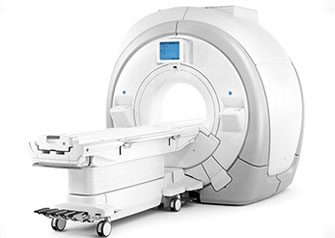What is Magnetic Resonance Imaging (MRI)?
Magnetic resonance imaging (MRI) is a computer-based diagnostic imaging procedure that uses a large magnetic field and radio waves to produce detailed images of the structures of the body to detect any abnormalities. It is particularly useful for imaging of the soft tissues which are not well visualized on X-rays.

Our new Brookfield location has a wide bore MRI machine
Indications for Magnetic Resonance Imaging (MRI)
Magnetic resonance imaging can help diagnose Injuries to the
- Bones
- Joints, or soft tissues damage to cartilage
- Muscles, or tendons
- Inflammatory diseases
- Musculoskeletal tumors
- Bone infections
- Degenerative conditions
- Bone marrow diseases
- Disc herniation
- Nerve damage
- Damage to blood vessels
Preparation for Magnetic Resonance Imaging
Inform your doctor if you have any health conditions, if you are pregnant or if you have any metal implants or materials in your body. You may be advised against having the procedure.
Magnetic resonance imaging does not require much preparation:
- Do not stop taking your medications unless instructed by your doctor.
- Remove jewelry or other metal items prior to the procedure.
- You will be instructed to wear loose-fitting clothes or change into a patient gown.
Procedure for Magnetic Resonance Imaging
The traditional MRI machine is a tunnel-shaped tube with a table that slides through it and both ends open.
- You will be instructed to lie down on a sliding table that will move into the open tube.
- If you have problems with claustrophobia, sedative medication may be administered to keep you calm during the procedure.
- A contrast dye, usually gadolinium, may be injected to improve the visualization of certain structures.
- The MRI machine produces a strong magnetic field and radio waves.
- Protons in the water molecules of your body respond to the magnetic field and radio waves by realigning themselves and producing signals which are picked up by a detector and processed to create the images.
- When contrast dye is injected, it helps visualize certain internal structures more clearly.
- It is normal to hear loud tapping sounds during the scanning procedure.
- The procedure may last from 15 minutes to 90 minutes depending on the part of the body being imaged.
Post-procedure Care Instructions for Magnetic Resonance Imaging (MRI)
If you are not sedated, you can immediately resume your regular activities. Otherwise, you will require a period of recovery until the medication has worn off or to see if you develop any side effects to the contrast agent.
Risk and Complications of Magnetic Resonance Imaging (MRI)
MRI imaging does not use radiation and is quite a safe procedure. Certain people may feel claustrophobic during the procedure for which medication can be provided. Complications may occur due to the contrast dye but are rare. This includes:
- Redness or swelling at the injection site due to leakage of the contrast
- Burning sensation
- Asthma (allergic reaction)
- Itching
- Anemia
- Nausea
